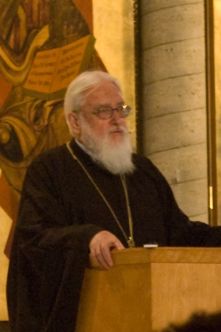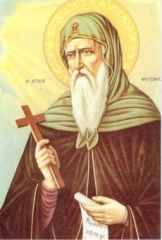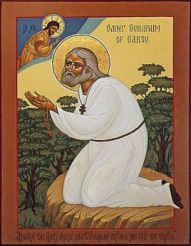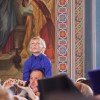Source: Saint Paul’s Greek Orthodox Church
 More important than all possible books if we are climbing a mountain for the first time, we need to follow a known route; and we also need to have with us, as companion and guide, someone who has been up before and is familiar with the way. To serve as such a companion and guide is precisely the role of the “abba” or spiritual father — of the one whom the Greeks call geron or geronta and the Russians starets, a title which in both languages means “old man” or “elder.”[1]
More important than all possible books if we are climbing a mountain for the first time, we need to follow a known route; and we also need to have with us, as companion and guide, someone who has been up before and is familiar with the way. To serve as such a companion and guide is precisely the role of the “abba” or spiritual father — of the one whom the Greeks call geron or geronta and the Russians starets, a title which in both languages means “old man” or “elder.”[1]
The importance of obedience to a geron is underlined from the very first beginnings of Eastern Christian monasticism. It is clearly evident, for example, in the sayings attributed to St Antony of Egypt:
I know of monks who fell after much toil and lapsed into madness, because they trusted in their own works and did not give due heed to the commandment of him who says, “Ask your father, and he will tell you” (Dent 32:7). If possible, for every step that a monk takes, for every drop of water that he drinks in his cell, he should entrust the decision to the old men, to avoid making some mistake in what he does. [2]
The need for spiritual guidance is a master-theme throughout the Apophthegmata or Sayings of the Desert Fathers:
The old men used to say: “If you see a young monk climbing up to heaven by his own will, grasp him by the feet and throw him down, for this is to his profit… If a person places his faith in someone else and surrenders himself to the other in full submission, he has no need to attend to the commandment of God, but he needs only to entrust his entire will into the hands of his father. Then he will be blameless before God, for God requires nothing from beginners so much as self-stripping through obedience.”[3]
This figure of the starets, so prominent in the first generations of Egyptian monasticism, has retained its full significance up to the present day in Orthodox Christendom. “There is one thing more important than all possible books and ideas,” states a Russian layman of the nineteenth century, the Slavophil Ivan Kireyevsky, “and that is the example of an Orthodox starets, before whom you can lay each of your thoughts and from whom you can hear, not a more or less valuable private opinion, but the judgement of the Holy Fathers. God be praised, such startsi have not yet disappeared from our Russia.”[4] And a priest of the Russian emigration in the twentieth century, Father Alexander Elchaninov, writes: “Their field of action is unlimited… they are undoubtedly saints, recognized as such by the people. I feel that in our tragic days it is precisely through this means that faith will survive and be strengthened in our country.”[5]
The spiritual guide as a “charismatic “figure
What entitles someone to act as spiritual guide? How and by whom is he or she appointed?
To this there is a simple answer. The elder or starets is essentially a “charismatic” and prophetic figure, accredited for her or his task by the direct action of the Holy Spirit. Spiritual guides are ordained, not by human hands, but by the hand of God. They are an expression of the Church as “event” or “happening,” rather than of the Church as institution.[6] There is, however, no sharp line of demarcation between the prophetic and the institutional elements in the life of the Church; each grows out of the other and is intertwined with it. The ministry of the starets, itself charismatic, is related to a clearlydefined function within the institutional framework of the Church, the office of priestconfessor. In the Orthodox tradition, the right to hear confessions is not granted automatically at ordination. Before acting as confessor, a priest requires authorization from his bishop; and in the Greek Church, at any rate, only a minority of the clergy are so authorized. Yet, although the sacrament of confession is certainly an appropriate occasion for spiritual direction, the ministry of the starets is by no means identical with that of a confessor. The starets gives advice, not only at confession, but on many other occasions. Moreover, while the confessor must always be a priest, the starets may be a simple monk, not in holy orders, or even a layman; the ministry of eldership may also be exercised by a nun or a laywoman, for in the Orthodox tradition there are spiritual mothers as well as spiritual fathers.[7] The starets, whether ordained or lay, frequently speaks with an insight and authority that only a very few confessor-priests possess.
If, however, spiritual fathers or mothers are not appointed by an official act of the hierarchy, how then do they come to embark on their ministry? Sometimes an existing starets will designate his own successor. In this way, at certain monastic centers such as Optino in nineteenth-century Russia there was established an “apostolic succession” of spiritual masters. In other cases, the starets emerges spontaneously, without any act of external authorization. As Father Alexander Elchaninov says, they are “recognized as such by the people.” Within the continuing life of the Christian community, it becomes plain to the believing people of God-which is the true guardian of Holy Tradition — that this or that person has the gift of spiritual fatherhood or motherhood. Then, in a free and informal fashion, others begin to come to him or her for advice and direction.
It will be noted that the initiative comes, as a rule, not from the master but from the disciples. It would be perilously presumptuous for someone to say in his own heart or to others, “Come and submit yourselves to me; I am a starets, I have the grace of the Spirit.” What happens, rather, is that — without any claims being made by the person himself — others approach him, seeking his advice or asking to live permanently under his care. At first, he will probably send them away, telling them to consult someone else. Eventually the moment comes when he no longer sends them away but accepts their coming to him as a disclosure of the will of God. Thus it is his spiritual children who reveal the elder to himself.
The figure of the geronta or starets illustrates the two interpenetrating levels on which the earthly Church exists and functions. On the one hand, there is the external, official and hierarchical level, with its geographical organization into dioceses and parishes, its great centers — Rome, Constantinople, Moscow, and Canterbury — and its “apostolic succession” of bishops. On the other hand, there is the inner, spiritual and “charismatic” level, to which the startsi primarily belong. Here the chief centers are, for the most part, not the great primatial and metropolitan sees but certain remote hermitages, in which there shine forth a few personalities richly endowed with spiritual gifts. Most startsi have possessed no exalted status in the formal hierarchy of the Church; yet the influence of a simple priest-monk such as St Seraphim of Sarov exceeded that of any patriarch or bishop in nineteenth-century Orthodoxy. In this fashion, alongside the apostolic succession of the episcopate, there exists also the apostolic succession of the saints and Spirit-bearers. Both types of succession are essential for the true functioning of the Body of Christ, and it is through their interaction that the life of the Church on earth is accomplished.
Flight and return: the preparation of the spiritual guide
Although spiritual guides are not ordained or appointed for their task, it is certainly necessary that they should be prepared. There is a classic pattern for this preparation, a movement of flight and return such as may be clearly discerned in the lives of St Antony the Great and St Seraphim of Sarov, to take but two examples separated from each other by fifteen centuries.
 St Antony’s life falls sharply into two halves, with his fiftyfifth year as the watershed. The years from early manhood to the age of fifty-five were his time of preparation, spent in an ever-increasing seclusion from the world as he withdrew further and further into the desert. According to his biographer, he eventually passed twenty years in an abandoned fort, meeting no one whatsoever. When he had reached the age of fifty-five, his friends could contain their curiosity no longer, and broke down the entrance. St Antony came out and, for the remaining half century of his long life, without abandoning the life of a hermit he made himself freely available to others, acting as “a physician given by God to Egypt,” to use the phrase of his biographer, St Athanasius. “He was beloved by all,” Athanasius states, “and all desired to have him as their father.”‘ Observe that the transition from enclosed anchorite to spiritual father came about, not through any initiative on St Antony’s part, but through the action of others. It should also be noted that Antony was a lay monk, never ordained to the priesthood[8].
St Antony’s life falls sharply into two halves, with his fiftyfifth year as the watershed. The years from early manhood to the age of fifty-five were his time of preparation, spent in an ever-increasing seclusion from the world as he withdrew further and further into the desert. According to his biographer, he eventually passed twenty years in an abandoned fort, meeting no one whatsoever. When he had reached the age of fifty-five, his friends could contain their curiosity no longer, and broke down the entrance. St Antony came out and, for the remaining half century of his long life, without abandoning the life of a hermit he made himself freely available to others, acting as “a physician given by God to Egypt,” to use the phrase of his biographer, St Athanasius. “He was beloved by all,” Athanasius states, “and all desired to have him as their father.”‘ Observe that the transition from enclosed anchorite to spiritual father came about, not through any initiative on St Antony’s part, but through the action of others. It should also be noted that Antony was a lay monk, never ordained to the priesthood[8].
 St Seraphim followed a comparable path. After sixteen years spent in the ordinary life of the monastic community, as novice, professed monk, deacon, and priest, he withdrew for twenty years of solitude, first as a hermit in the forest and then for the last three years, after being ordered by the abbot to return to the monastery, as a recluse enclosed in his cell. During part of these twenty years he met occasional visitors, but at other times his isolation was almost total: at the start of his time in the forest he spent a thousand days on the stump of a tree and the thousand nights of those days on a rock, devoting himself to unceasing prayer; for the last three years in his forest hut he spoke to no one; and during his three years of enclosure in the monastery he did not go to church even to receive Holy Communion, but the sacrament was brought to him at the door of his cell. Then in 1813, at the age of fifty-three, he ended his seclusion, devoting the last two decades of his life to the ministry of starchestvo (eldership) and receiving all who came to him, whether monks or laypeople. He did nothing to advertise himself or to call others to him; it was the others who took the initiative in approaching him, but when they came — sometimes hundreds or even thousands in a single day — he did not send them empty away.[9]
St Seraphim followed a comparable path. After sixteen years spent in the ordinary life of the monastic community, as novice, professed monk, deacon, and priest, he withdrew for twenty years of solitude, first as a hermit in the forest and then for the last three years, after being ordered by the abbot to return to the monastery, as a recluse enclosed in his cell. During part of these twenty years he met occasional visitors, but at other times his isolation was almost total: at the start of his time in the forest he spent a thousand days on the stump of a tree and the thousand nights of those days on a rock, devoting himself to unceasing prayer; for the last three years in his forest hut he spoke to no one; and during his three years of enclosure in the monastery he did not go to church even to receive Holy Communion, but the sacrament was brought to him at the door of his cell. Then in 1813, at the age of fifty-three, he ended his seclusion, devoting the last two decades of his life to the ministry of starchestvo (eldership) and receiving all who came to him, whether monks or laypeople. He did nothing to advertise himself or to call others to him; it was the others who took the initiative in approaching him, but when they came — sometimes hundreds or even thousands in a single day — he did not send them empty away.[9]
Without this intense ascetic preparation, without this radical flight into solitude, would St Antony or St Seraphim have been able to guide and inspire their contemporaries to the same degree? Not that they withdrew with the specific and conscious purpose of becoming the teachers and guides of others. They fled, not in order to prepare themselves for any such task, but simply out of a consuming desire to be alone with God. God accepted their love, but then He sent them back as instruments of healing in the world from which they had withdrawn. Even had He never sent them back, their flight would still have been supremely creative and valuable to society; for nuns and monks help the world not primarily by anything that they do and say but by what they are, by the state of unceasing prayer which — for some at any rate among them — has become identical with their innermost being. Had St Antony and St Seraphim done nothing but pray in solitude they would still have been serving others to the highest degree. As things turned out, however, God ordained that they should also serve them in a more direct fashion. Yet this direct and visible service was not their original aim: it was a side-effect that they had not themselves intended or initially envisioned, an outward consequence of the inner and invisible service which they were already rendering through their prayer.
“Acquire a peaceful spirit,” said St Seraphim, “and then thousands of others around you will be saved.”[10] Such is the pattern of spiritual fatherhood or motherhood. Establish yourself in God; then you can bring others to His presence. Each must learn to be alone, and so in the stillness of their own heart they will begin to hear the wordless speech of the Spirit, thus discovering the truth about themselves and about God. Then their word to others will be a word of power, because it is a word out of silence.
Shaped in this way by the encounter with God in solitude, the starets is able to heal by his very presence. He guides and forms others, not primarily by words of advice but by his companionship, by the living and specific example which he sets. He teaches as much by his stillness as by his speech, by his very presence as much as by any word of counsel that he utters. That is why Abba Pambo saw no reason to say anything to Archbishop Theophilus of Alexandria: “If he isn’t edified by my silence,” observed the old man, “then he won’t be edified by my words.”[11] A story with the same moral is told of St Antony. “It was the custom of three Fathers to visit the Blessed Antony once each year, and two of them used to ask him questions about their thoughts (logismoi) and the salvation of their soul; but the third remained completely silent, without putting any questions. After a long while, Abba Antony said to him, ‘See, you have been in the habit of coming to me all this time, and yet you do not ask me any questions.’ And the other replied, ‘Father, it is enough for me just to look at you.'”[12]
The real journey of the starets, however, is not spatially into the desert, but spiritually into the heart. External solitude, however valuable, is not indispensable, and a person may learn to stand alone before God while yet continuing to pursue a life of active service in the midst of society. The story of the Alexandrian doctor who was the equal of St Antony, and who all day long sang the Thrice-Holy Hymn with the angels,[13] shows us that the mystical and “angelic” life is possible in the city as well as the desert. Unceasing prayer of the heart is no monopoly of the eremitic solitary; for people such as the Alexandrian doctor have accomplished the inner journey without severing their outward links with the community.
This pattern of flight and return, then, is not to be understood in too literal and clear-cut a way. The two stages need not necessarily be expressed in external and spatial terms; and by the same token the flight and return are not always sharply distinguished in temporal sequence. Take, for example, the case of St Seraphim’s younger contemporary, St Ignaty Brianchaninov. Trained originally as an army officer, he then withdrew to a monastery; but after only four years in monasticism he was appointed at the early age of twenty-six to take charge of a busy and influential community close to the heart of St Petersburg. After twenty-four years as abbot, he was consecrated bishop. Four years later he resigned, to spend the remaining six years of his life as a hermit. Thus in St Ignaty’s case a long period of active pastoral work and spiritual fatherhood preceded the period of his eremitic seclusion. When he was originally made abbot, he must surely have felt ill-prepared. His secret withdrawal into the heart was undertaken continuously during the many years in which he administered a monastery and a diocese; but it did not receive an exterior expression until the very end of his life. The life of St Theophan the Recluse followed the same pattern: first an active pastorate, then the hermit’s cell.[14]
St Ignaty’s career may serve as a paradigm to many of us at the present time, even though we are conscious of falling far short of his level of spiritual achievement. Under the pressure of outward circumstances and probably without clearly realizing what is happening to us, we assume the responsibilities of teaching, preaching and pastoral counseling, while lacking any deep knowledge of the desert and its creative silence. But through instructing others we ourselves perhaps begin to learn. Slowly we recognize our powerlessness to heal the wounds of humanity solely through philanthropic programs, common sense and psychoanalysis. Our self-dependence is broken down, we appreciate our own inadequacy, and so we start to understand what Christ meant by the “one thing that is necessary” (Lk 10:42). That is the moment when a person may by the divine mercy start to advance along the path of the starets. Through our pastoral experience, through our anguish over the pain of others, we are brought to undertake the journey inwards and to seek the hidden treasure-house of the Kingdom, where alone a genuine solution to the world’s problems can be found. No doubt few if any among us would venture to think of ourselves as a starets in the full sense, but provided we seek with humble sincerity to enter into the “secret chamber” of our heart, we can all share to some degree in the grace of spiritual fatherhood or motherhood. Perhaps we shall never outwardly lead the life of a monastic recluse or a hermit — that often rests with circumstances outside our own control — but what is supremely important is that each should see the need to be a hermit of the heart.
[1] On spiritual fatherhood in the Christian East, the standard work is by Irйnйe Hausherr, Direction spirituelle en Orient autrefois, Orientalia Christiana Analecta 144 (Rome: Pont. Institutum Studiorum Orientalium, 1955); English translation, Spiritual Direction in the Early Christian East, Cistercian Studies Series 116 (Kalamazoo, MI: Cistercian Publications, 1990). Consult also I. Hadot, “The Spiritual Guide,” in A. H. Armstrong (ed.), Classical Mediterranean Spirituality: Egyptian, Greek, Roman (London: Routledge & Kegan Paul, 1986), 436-59; Graham Gould, The Desert Fathers on Monastic Community (Oxford: Clarendon Press, 1993), especially 26-87; Stephan B. Clark, Unordained Elders and Renewal Communities (New York/Paramus/Toronto: Paulist Press, 1976); John Chryssavgis, Ascent to Heaven. The Theology of the Human Person according to Saint John of the Ladder (Brookline, MA: Holy Cross Orthodox Press, 1989), 211-30; H. J. M. Turner, St. Symeon the New Theologian and Spiritual Fatherhood (Leiden: E. J. Brill, 1990). For a comparison between Climacus and Symeon, see my introduction to the English translation of Hausherr, Spiritual Direction, vii-xxxiii. On the Russian tradition, consult J. B. Dunlop, Staretz Amvrosy: Model for Dostoevsky’s Staretz Zossima (Belmont, MA: Nordland, 1972); I. de Beausobre (ed.), Macarius, Starets of Optino: Russian Letters of Direction 1834-1860 (Westminster: Dacre, 1944); Archimandrite Sophrony (Sakharov), Saint Silouan the Athonite (Tolleshunt Knights: Monastery of Saint John the Baptist, 1991). For modern Greek examples, see Elder Paisios of Mount Athos, Athonite Fathers and Athonite Matters (Thessalonica: Holy Convent of the Evangelist John the Theologian, Souroti, 1999). On Romania, see [Hiermonk Seraphim Rose], Blessed Paisius Velichkovsky (Platina, CA: Saint Herman of Alaska Brotherhood, 1976); Romul Joanta (now Metropolitan Seraphim of Germany and Central Europe), Roumanie: tradition et culture hйsychastes, Spiritualitй orientale 46 (Bйgrolles: Abbaye de Bellefontaine, 1987); English translation, Romania: Its Hesychast Tradition and Culture (Wildwood, CA: St Xenia Skete, 1992).
[2] AP, alphabetical collection, Antony 37, 38 (PG 65:88B); tr. Ward, 8-9 (the translation needs correcting).
[3] AP, anonymous collection, 244, 290: ed. Nau, ROC 14 (1909), 364, 376; tr. Ward, Wisdom, §§112,158 (34, 45).
[4] Cited by Ivan Tschetwerikow, in Metropolitan Seraphim (ed.), L’Eglise Orthodoxe (Paris: Payot, 1952), 219.
[5] Elchaninov, The Diary of a Russian Priest, 54.
[6] I use “charismatic” in the restricted sense customarily given to it by contemporary writers. But if that word indicates (as properly it should) someone who has received the gifts or charismata of Holy Spirit, then the ministerial priest, ordained through the episcopal laying on of hands, is as genuinely “charismatic” as one who speaks with tongues.
[7] In the alphabetical collection of the Sayings of the Desert Fathers, alongside 127 “abbas” there are three “ammas” or spiritual mothers: the women are in a minority, but they have their place in the Gerontikon. See Sister Benedicta Ward, “`Apophthegmata Matrum,”, Studia Patristica 16:2, Texte and Untersuchungen 129 (Berlin: Akademie Verlag, 1985), 63-66; Joseph M. Soler, “Les Mиres du dйsert et la maternitй spirituelle,” Collectanea Cisterciensia 48 (1986), 235-50.
[8] Life of Antony, 87 and 81; tr. Gregg, 94, 90.
[9] I follow here the generally accepted chronology of St Seraphim’s life. But there is evidence to suggest that he may have begun his ministry as starets at a much earlier point, before his withdrawal into the forest in 1794. Yet even so the pattern of flight and return still holds good in Seraphim’s case, at any rate in general terms; for, prior to 1813, his ministry as starets was restricted and sometimes totally interrupted. See Vsйvolod Rochcau, Saint Sйraphim: Sarov et Divйyevo. Йtudes et Documents, Spiritualitй Orientale 45 (Bйgrolles: Abbaye de Bellefontaine, 1987), 53-84.
[10] Archimandrite Lazarus Moore, St. Seraphim of Sarov, 126.
[11] AP, alphabetical collection, Theophilus 2; quoted above, 89.
[12] AP, alphabetical collection, Antony 27 (84D); tr. Ward, Sayings, 7.
[13] AP, alphabetical collection, Antony 24 (84B); see above, 86.
[14] On Ignaty and Theophan, see the introduction to Igumen Chariton, The Art of Prayer, 11-15. St Tikhon of Zadonsk is yet another example of one who, after many years of active pastorate, only became a recluse at the end of his life.















